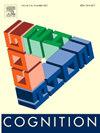Out of sight, but still in the mind: Body-specific associations between space and valence in blind people
IF 2.8
1区 心理学
Q1 PSYCHOLOGY, EXPERIMENTAL
引用次数: 0
Abstract
A substantial body of evidence demonstrates that individuals tend to associate positive concepts with their dominant side of space in their mental models. However, prior research indicates that the left-is-good bias among left-handed individuals is stronger than the right-is-good bias observed in right-handed individuals. One potential explanation for this asymmetry is that right-handers, during face-to-face interactions with predominantly right-handed communicators, experience a vicarious form of motor fluency that may contradict their own actions, thereby diminishing their bias toward the right-is-good mapping. However, this hypothesis has yet to be empirically tested. Here, we investigated this assertion by examining the role of visual experience in the scalability of the body-specificity effect among early blind (N = 123; 54.5 % females, mean age = 27.02) and sighted right-handers (N = 127; 54.3 % females, mean age = 28.93). Our results reveal that both Chinese blind and sighted individuals exhibited a body-specificity effect in their mental representations. Notably, the strength of the right-is-good pattern in blind right-handers was more pronounced than that observed in sighted controls. Collectively, our findings not only provide empirical evidence for the body-specificity effect within blind populations but also support the role of vicarious experiences in the development of implicit space-valence associations.
看不见,但仍在脑海中:盲人的空间和价之间的身体特异性关联
大量的证据表明,个体倾向于将积极的概念与他们心理模型中占主导地位的空间联系起来。然而,先前的研究表明,左撇子个体的“左好”倾向强于右利手个体的“右好”倾向。对这种不对称的一种潜在解释是,右撇子在与主要是右撇子的交流者面对面的交流中,会体验到一种与自己的行为相矛盾的替代形式的运动流畅,从而减少了他们对“右为善”映射的偏见。然而,这一假设尚未得到实证检验。在这里,我们通过检查视觉经验在早期失明(N = 123;女性54.5%,平均年龄27.02岁)和视力正常的右撇子(N = 127;女性54.3%,平均年龄28.93岁)。结果表明,中国盲人和视力正常的人在心理表征中都表现出身体特异性效应。值得注意的是,在盲人右撇子中,“右就是好”模式的强度比在视力正常的对照组中观察到的更为明显。总的来说,我们的研究结果不仅为盲人群体的身体特异性效应提供了经验证据,而且还支持了替代经验在内隐空间效价关联发展中的作用。
本文章由计算机程序翻译,如有差异,请以英文原文为准。
求助全文
约1分钟内获得全文
求助全文
来源期刊

Cognition
PSYCHOLOGY, EXPERIMENTAL-
CiteScore
6.40
自引率
5.90%
发文量
283
期刊介绍:
Cognition is an international journal that publishes theoretical and experimental papers on the study of the mind. It covers a wide variety of subjects concerning all the different aspects of cognition, ranging from biological and experimental studies to formal analysis. Contributions from the fields of psychology, neuroscience, linguistics, computer science, mathematics, ethology and philosophy are welcome in this journal provided that they have some bearing on the functioning of the mind. In addition, the journal serves as a forum for discussion of social and political aspects of cognitive science.
 求助内容:
求助内容: 应助结果提醒方式:
应助结果提醒方式:


